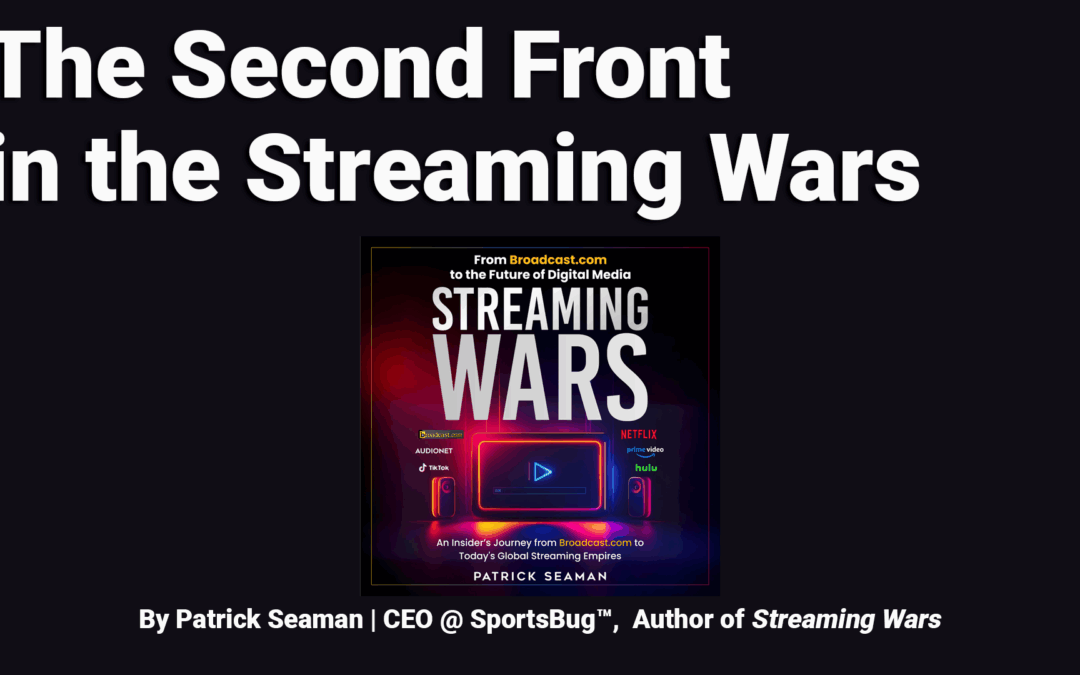The Second Front in the Streaming Wars
By Patrick Seaman | CEO @ SportsBug™, Author of Streaming Wars
When we built Broadcast.com, we proved that once people had the choice, they would never go back. The shift from linear programming to consumer-controlled access created a new kind of audience: one that demanded control over both content and context. Three decades later, the same war continues, but the battle lines have shifted. The fight is no longer about bandwidth or codecs. It’s about who owns the story, who curates the feed, and who decides what the world gets to watch.
Last week’s headlines made that plain. Netflix will begin hosting Spotify video podcasts. Apple quietly dropped the “+” from Apple TV. Charter launched a Spectrum app store. And RTL moved its streaming infrastructure onto a third-party platform. Each of these stories is a symptom of the same long arc I described in Streaming Wars: control migrates toward whoever manages access, not whoever creates the content.
Convergence and the Collapse of Categories
When Netflix begins carrying Spotify’s podcasts, it isn’t just a business deal. It’s an admission that the borders between video and audio are dissolving. The next front isn’t “who owns the biggest catalog.” It’s “who owns the daily habit.” This is the same tension we saw when Yahoo! bought Broadcast.com and tried to fold a living ecosystem into a corporate container. The technology worked. The strategy didn’t.
In Streaming Wars, I wrote that the battle for streaming isn’t just about tech. It’s about who controls the stories we watch. Netflix is no longer just distributing stories. It’s trying to absorb the language of every medium (film, series, podcast, and live event) into a single feed it controls. The more unified the format, the more invisible the walls become.
Rebranding and the Illusion of Simplicity
Apple’s decision to drop the “+” from Apple TV looks minor but signals fatigue with constant segmentation. In Streaming Wars, I described how the evolution of streaming isn’t just about technology. It’s about who controls distribution. That’s what Apple understands. When every company is a platform and every platform is a bundle, simplicity becomes a competitive weapon. The name change says: this is not one more add-on. It’s the ecosystem itself.
The irony is that we’ve returned to a form of cable, but with prettier interfaces and multiple monthly opt-outs instead of long-term contracts. The freedom consumers gained from cutting cords has been replaced by algorithmic bundles. The illusion of choice is still the product.
Infrastructure Becomes Identity
Charter’s new app store and RTL’s migration to Bedrock look like infrastructure moves, but they point to a deeper shift. Control is passing from the brands we recognize to the technologies beneath them. In the early Broadcast.com years, we learned that if you don’t control your content, you don’t control your future. The same is true now for platforms that rely on third-party tech stacks. Once your delivery pipeline belongs to someone else, so does your destiny.
That’s why today’s “platform wars” are really protocol wars. Whoever defines the playback, the authentication, and the metrics defines the market. The rest is decoration.
Regulation, Reality, and the End of Excess
California’s recently enacted SB 576, signed into law on October 6, 2025, requires streaming services (Netflix, Hulu, Prime Video, YouTube) to ensure that advertisements do not exceed the average volume of the surrounding programming. This measure, effective July 1, 2026, aims to prevent sudden volume spikes in ads.
To some, this may seem trivial, but it mirrors the Commercial Advertisement Loudness Mitigation (CALM) Act of 2010. Under FCC rules implementing the CALM Act, commercials on broadcast, cable, and satellite TV must maintain the same average volume as the programs they accompany. This applies to all TV providers.
Radio has no equivalent federal regulation beyond overmodulation rules intended to prevent distortion. The NAB has voluntary standards, and there are industry and engineering guidelines. But since radio has historically been local, it has generally been more in tune with its listening audience and subject to their feedback.
All of this reminds us that technology without user trust eventually triggers correction. While noticeable volume changes sometimes happen because a feed isn’t properly normalized (a technical issue), we all know that some advertisers intentionally jack up the volume on ads. It would be interesting to see studies analyzing the effect this practice has on brand awareness, perception, and actual sales.
Among the many themes in Streaming Wars was an awareness that no company or technology stays dominant forever. Regulation is generally a slow and tortuous process. Given how slow it is, when it happens, it should serve as a wake-up call.
What Comes Next
I opened my book with the buffer wheel, that spinning reminder that something amazing was about to happen. With the advent of broadband and CDNs, the wheel has largely vanished, but the waiting has returned in other forms: through paywalls, pre-rolls (my apologies for inventing it), and platform fatigue. The next phase won’t be about more content. It will be about trust, ownership, and authenticity.
The question isn’t who can stream faster. It’s who we let decide what plays next.
If you want to dig deeper into how we got here and where the industry is headed, check out Streaming Wars on Amazon.

Recent Comments